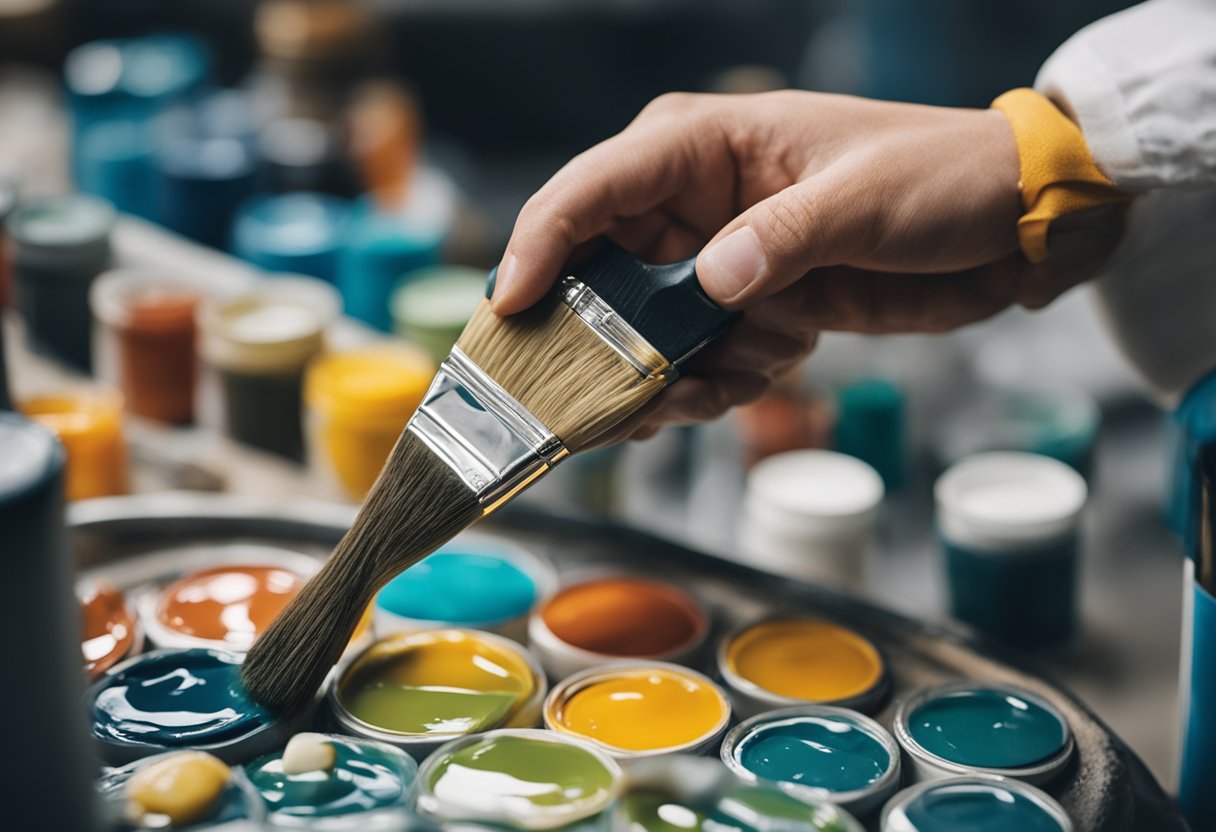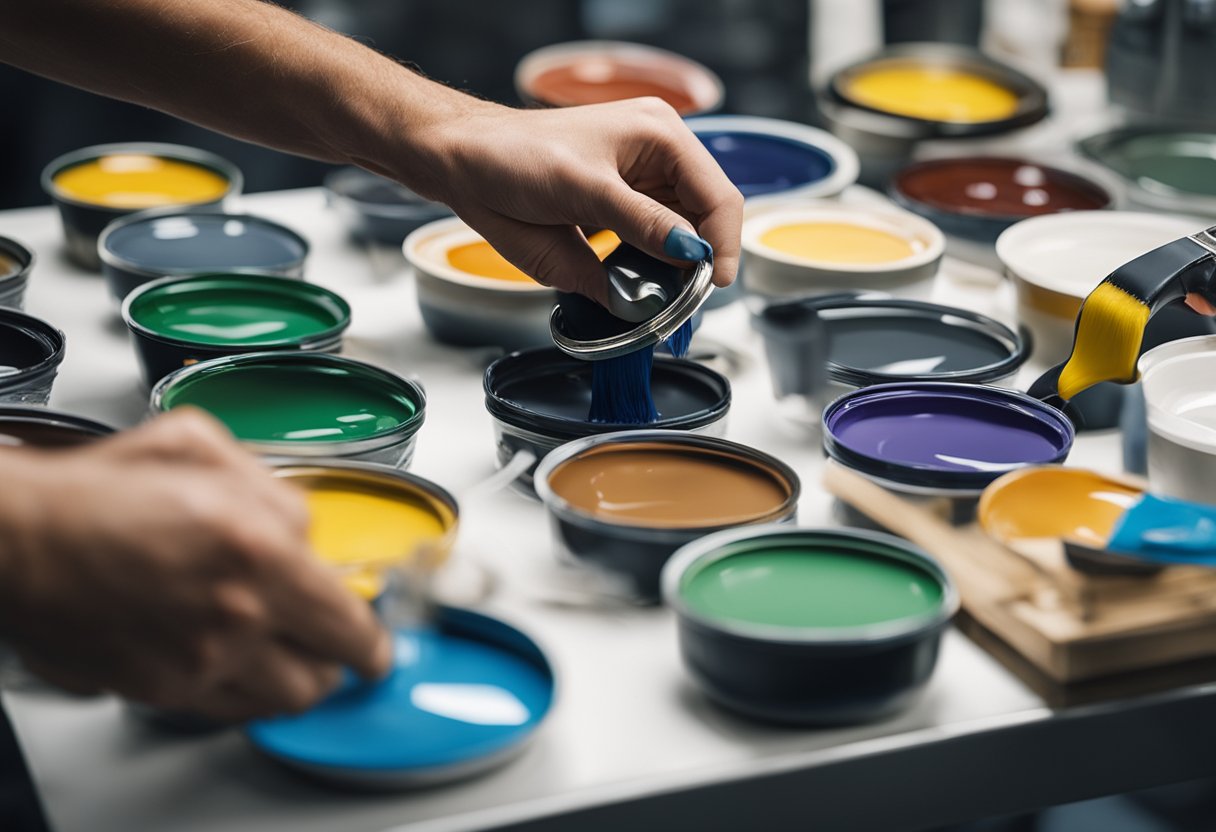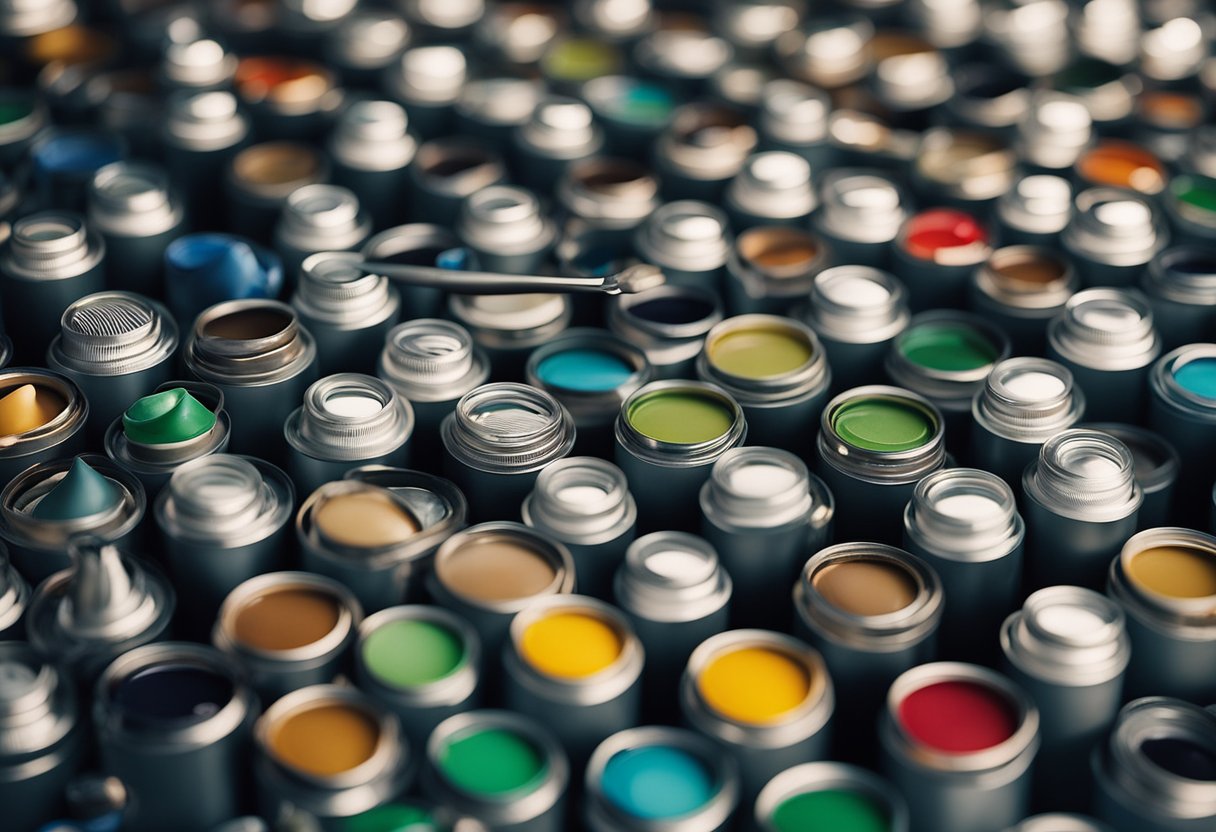I have extensive experience in painting ceramics with acrylic paint, and I know firsthand how important it is to properly seal the paint to ensure the artwork lasts for years to come. In this article, I will share my knowledge and provide a step-by-step guide on how to seal acrylic paint on ceramic.
Understanding the properties of acrylic paint and ceramic is crucial before applying any sealant. Acrylic paint is a water-based paint that dries quickly and forms a flexible, durable film on the surface it is applied to. Ceramic is a non-porous material that can be glazed or unglazed. When painting on ceramic with acrylic paint, it is important to choose the right sealant to protect the paint from scratches, fading, and general wear and tear.
In the next section, I will discuss the preparation stage, including the materials needed and the steps to take before applying the sealant. Then, I will cover the different types of sealants available and how to choose the right one for your specific project. Finally, I will provide a step-by-step guide on how to seal acrylic paint on ceramic, including special considerations and common mistakes to avoid.
Key Takeaways
- Understanding the properties of acrylic paint and ceramic is crucial for properly sealing the paint.
- Choosing the right sealant is important to protect the paint from scratches, fading, and general wear and tear.
- Following a step-by-step guide and avoiding common mistakes will ensure a long-lasting artwork.
Understanding Acrylic Paint and Ceramic
https://www.youtube.com/watch?v=r_R-qniz7-4&embed=true
I have found that when it comes to painting on ceramics, acrylic paint is a popular choice due to its versatility and durability. Acrylic paint is a water-based paint that is made up of pigment suspended in an acrylic polymer emulsion. This type of paint dries quickly and is known for its vibrant colors and ability to adhere to a variety of surfaces, including ceramics.
Ceramic is a term that refers to a wide range of materials that are made from clay and other natural materials. Ceramics can be glazed or unglazed and can be painted with a variety of materials, including acrylic paint. When painting on ceramics, it is important to understand the properties of the surface to ensure that the paint adheres properly and does not chip or peel.
When using acrylic paint on ceramic, it is important to prepare the surface properly. This involves cleaning the surface thoroughly and ensuring that it is free from any dust or debris. Once the surface is clean, it is important to apply a base coat of paint to help the paint adhere properly.
When mixing colors for acrylic paint on ceramic, it is important to use a palette knife to ensure that the colors are mixed evenly. This can help to prevent streaking and ensure that the colors are consistent throughout the painting.
Acrylic resin is a common ingredient in acrylic paint and is what gives the paint its durability and water resistance. When painting on ceramics, it is important to choose a paint that contains a high-quality acrylic resin to ensure that the paint will stand up to wear and tear.
Overall, understanding the properties of acrylic paint and ceramic is key to creating a successful painting. By following the proper techniques and using high-quality materials, it is possible to create stunning and long-lasting artwork on ceramic surfaces.
Preparation Stage
https://www.youtube.com/watch?v=8ImpKNTJyPA&embed=true
Before sealing acrylic paint on ceramic, it is important to properly prepare the surface. This will ensure that the paint adheres well and the final result is long-lasting and durable.
Firstly, I make sure that the ceramic surface is clean and free from any dust or debris. I use a soft cloth to wipe the surface gently and remove any loose particles. This is important because any dust or debris left on the surface can cause the paint to adhere poorly and result in a patchy finish.
Next, I avoid using abrasive cleaners or harsh chemicals to clean the surface. Instead, I use a mild soap and water solution to gently clean the ceramic surface. This helps to remove any dirt or grime without damaging the surface.
It is also important to work in a well-ventilated area when preparing the ceramic surface. This is because some sealants can emit fumes that may be harmful if inhaled. I make sure to open windows or use a fan to ensure adequate ventilation.
Overall, proper preparation of the ceramic surface is essential for a successful sealing process. By following these simple steps, I can ensure that the surface is clean, free from debris, and ready for the next step of the process.
Choosing the Right Sealant
https://www.youtube.com/watch?v=j_I0bhZ6jrc&embed=true
When it comes to sealing acrylic paint on ceramic, choosing the right sealant is crucial. Not only does it ensure the longevity of your artwork, but it also affects the overall look and feel of the finished product. In this section, I will discuss the different types of sealants available and their respective finishes.
Types of Sealants
There are several types of sealants that can be used to seal acrylic paint on ceramic. Here are some of the most common ones:
-
Polyurethane Varnish: This type of sealant is durable and versatile. It can be used on a variety of surfaces, including ceramic, wood, and plastic. Polyurethane varnish comes in both water-based and oil-based formulas, and it can be applied with a brush or sprayed on. It provides a clear, glossy finish that is highly durable and non-toxic.
-
Acrylic Polymer Emulsion: This type of sealant is water-based and provides a clear, non-yellowing finish. It is also non-toxic and easy to clean up. Acrylic polymer emulsion can be applied with a brush or sprayed on, and it dries quickly.
-
Epoxy Resin: This type of sealant is highly durable and provides a glossy finish. It is often used on surfaces that will be exposed to water or other liquids, such as ceramic mugs or plates. Epoxy resin can be applied with a brush or poured on, and it requires a longer drying time than other sealants.
Sealant Finishes
The finish of the sealant you choose can greatly affect the overall look of your artwork. Here are the most common types of finishes:
-
Glossy Finish: This finish is highly reflective and provides a shiny, polished look. It is often used on surfaces that require a high level of durability, such as ceramic tiles or outdoor sculptures.
-
Matte Finish: This finish is non-reflective and provides a flat, smooth look. It is often used on surfaces that require a more subtle, understated look, such as canvas paintings or indoor sculptures.
-
Satin Finish: This finish provides a subtle, semi-gloss look. It is often used on surfaces that require a balance between durability and subtlety, such as ceramic plates or pottery.
In conclusion, choosing the right sealant is crucial when sealing acrylic paint on ceramic. Consider the type of surface you are working with, the level of durability you require, and the overall look you want to achieve when selecting a sealant. Whether you choose a clear, water-based sealant or a high-quality varnish, the right sealant will ensure that your artwork looks great and lasts for years to come.
The Sealing Process
https://www.youtube.com/watch?v=lOfVz8-qI6M&embed=true
After completing the acrylic paint on ceramic, it’s important to seal it properly to protect the artwork from fading, chipping, scratches, and other damages. Sealing the acrylic paint also enhances the vibrancy and lightfastness of the colors. Here is a step-by-step guide on how to seal acrylic paint on ceramic.
Step-by-Step Guide
-
First, ensure that the acrylic paint is completely dry. Applying the sealant on wet paint can cause it to smear and ruin the artwork.
-
Clean the ceramic surface with mild soap and water, and let it dry completely.
-
Apply the sealant in thin, even strokes using a soft paintbrush or sponge. It’s important to apply the sealant in smooth and even strokes to avoid any brush marks or unevenness.
-
Apply thin coats of the sealant. Applying too thick of a coat can cause the sealant to crack or peel off. It’s better to apply multiple thin coats than one thick coat.
-
Let each coat dry completely before applying the next coat. The drying time can vary depending on the type of sealant used.
-
Repeat the process until you have applied enough coats to ensure proper protection of the artwork.
Curing and Drying
After applying the final coat of sealant, the ceramic piece needs to be cured and dried properly. The curing time can vary depending on the type of sealant used and the manufacturer’s instructions.
Some sealants require kiln-firing to cure properly, while others can air dry. It’s important to follow the manufacturer’s instructions for curing and drying to ensure the best results.
In conclusion, sealing the acrylic paint on ceramic is an easy process that can be done in 10 steps. By following the step-by-step guide and allowing proper curing and drying time, the artwork can be protected from fading, chipping, scratches, and other damages.
Special Considerations
https://www.youtube.com/watch?v=X9xXQqZXtXk&embed=true
When it comes to sealing acrylic paint on ceramic, there are a few special considerations to keep in mind. First and foremost, it is important to choose the right type of sealant for your project. Some sealants are specifically designed for use on glazed ceramic, while others are better suited for bisque, earthenware, stoneware, or porcelain bisque.
Another important consideration is whether the sealant is dishwasher safe. If you plan on using your painted ceramic plates or mugs for food or drink, it is essential to choose a sealant that can withstand the heat and pressure of a dishwasher cycle. Look for sealants that are labeled as “dishwasher safe” or “food safe” to ensure that your creations are both beautiful and functional.
It is also important to note that the application process for sealing acrylic paint on ceramic can vary depending on the type of ceramic you are working with. For example, greenware requires a different approach than bisque or already glazed ceramic. It is important to research the specific requirements for your chosen type of ceramic and follow the instructions carefully.
Finally, it is important to keep in mind that sealing acrylic paint on ceramic requires patience and attention to detail. It is essential to allow each layer of paint and sealant to dry completely before applying the next, and to apply thin, even coats to avoid drips and bubbles. With the right tools, materials, and techniques, however, anyone can create beautiful, long-lasting works of art on ceramic surfaces.
Common Mistakes and Tips
When it comes to sealing acrylic paint on ceramic, there are a few common mistakes that can be easily avoided. Here are some tips to help you achieve a smooth and even seal:
-
Not waiting for the paint to dry completely: One of the most common mistakes is not waiting long enough for the paint to dry before applying the sealant. It’s important to wait at least 24 hours before sealing the paint to ensure that it has fully dried.
-
Using too much sealant: Another common mistake is using too much sealant. This can result in a thick, uneven layer that may take longer to dry and may even crack over time. It’s best to apply thin, even layers of sealant and let each layer dry completely before applying the next.
-
Not cleaning the surface properly: Before applying the sealant, it’s important to clean the ceramic surface thoroughly. Any dirt, dust, or oils on the surface can affect the adhesion of the sealant and result in a poor seal. Use a mild soap and water to clean the surface and let it dry completely before applying the sealant.
-
Using the wrong type of sealant: Not all sealants are created equal. It’s important to choose a sealant that is specifically designed for ceramic surfaces and compatible with acrylic paint. Using the wrong type of sealant can result in a poor seal and may even damage the paint.
-
Not following the manufacturer’s instructions: Finally, it’s important to read and follow the manufacturer’s instructions carefully when applying the sealant. This will ensure that you achieve the best possible results and avoid any potential problems.
By following these tips and avoiding these common mistakes, you can achieve a smooth and even seal on your acrylic painted ceramic surface.
Frequently Asked Questions
What is the best sealant for acrylic paint on ceramic?
The best sealant for acrylic paint on ceramic is a clear, water-resistant, and non-yellowing sealant. A ceramic or dishwasher-safe clear glaze is recommended as it provides a protective layer that prevents the paint from chipping, fading, or peeling. Epoxy resin is also an option if you want a glossy finish on your acrylic painted ceramic.
How do you make acrylic paint stay on ceramic?
To make acrylic paint stay on ceramic, you need to prepare the ceramic surface properly before painting. Clean the surface with mild soap and water, let it dry completely, and then apply a primer that is specifically designed for use on ceramics. Once the primer is dry, you can paint the ceramic with acrylic paint and then seal it with a clear, water-resistant, and non-yellowing sealant.
Is acrylic paint waterproof on ceramic?
Acrylic paint is water-resistant on ceramic, but it is not completely waterproof. If you want to make your acrylic painted ceramic waterproof, you need to seal it with a clear, water-resistant, and non-yellowing sealant. This will provide a protective layer that prevents the paint from getting damaged by water.
Can you use clear nail polish to seal acrylic paint on ceramic?
Using clear nail polish to seal acrylic paint on ceramic is not recommended. Nail polish is not designed to be used as a sealant on ceramic and may not provide adequate protection. It may also yellow over time, which can affect the appearance of your painted ceramic.
Can you eat off of ceramic plates sealed with acrylic paint?
It is not recommended to eat off of ceramic plates sealed with acrylic paint. While the sealant provides a protective layer, it is not food-safe and may contain chemicals that are harmful if ingested. If you want to use your painted ceramic for food, it is best to use a food-safe sealant that is specifically designed for use on ceramics.
Is there a difference between sealing acrylic paint on glazed and unglazed ceramic?
Yes, there is a difference between sealing acrylic paint on glazed and unglazed ceramic. Glazed ceramic has a smooth surface that is less porous than unglazed ceramic. This means that the sealant may not adhere as well to glazed ceramic and may require additional coats. Unglazed ceramic, on the other hand, is more porous, which means that the sealant may absorb more easily and require fewer coats.

Hi, I’m Sal Muller of Tooltrip.com. My DIY experience led me to understand essential power tools for home projects. Tooltrip.com guides enthusiasts and professionals in choosing right tools for any job. I provide concise top tool reviews for easier, efficient DIY.




